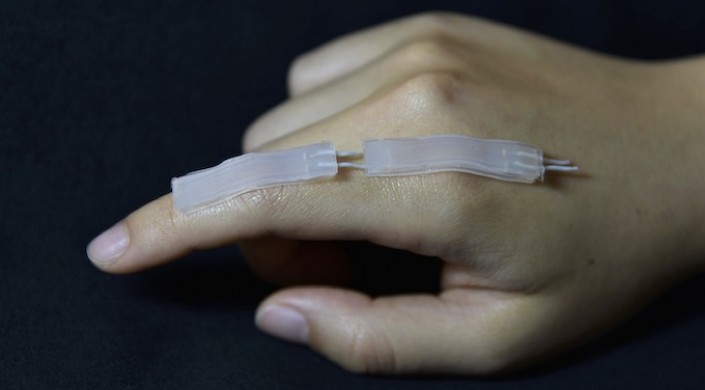Development of a Safe and Wearable Biosensor
Researchers at Harvard University have developed a non-toxic wearable sensor consisting of a silicon-rubber that attaches to the hand and capable of mearing the force of grasp and motion. The sensor includes a non-toxic novel element consisting of a highly conductive liquid solution. "We have developed a new type of conductive liquid that is no more dangerous than a small drop of salt water," says Siyi Xu, a graduate student and first author of the study. "It is four times more conductive than previous biocompatible solutions, leading to cleaner, less noisy data."
The solution is composed from potassium iodide and glycerol which make it highly stable and conductive for sensing. "Previous biocompatible soft sensors have been made using sodium chloride-glycerol solutions but these solutions have low conductivities, which makes the sensor data very noisy, and it also takes about 10 hours to prepare," explains Xu. "We've shortened that down to about 20 minutes and get very clean data."
Although the sensor was tested only on adult hands, the sensor is appropriate for advancing the therapeutic process of children with developmental disabilities. "We often see that children who are born early or who have been diagnosed with early developmental disorders have highly sensitive skin," says co-author, Eugene Goldfield. "By sticking to the top of the finger, this device gives accurate information while getting around the sensitively of the child's hand."
This biocompatible sensor is made from a non-toxic, highly conductive liquid solution that could be used in diagnostics, therapeutics, human-computer interfaces, and virtual reality. (Image courtesy of Siyi Xu, Daniel M. Vogt, and Andreas W. Rousing/Harvard SEAS)
Researchers are hopeful to scale their sensor down and test its efficacy on children—which can be critical in the diagnosis of neuromotor and cognitive development disabilities. "Early diagnosis is the name of the game when it comes to treating these developmental disabilities and this wearable sensor can give us a lot of advantages not currently available," said Goldfield.
Results of the study were published in Advanced Functional Materials.
Source: Science Daily









